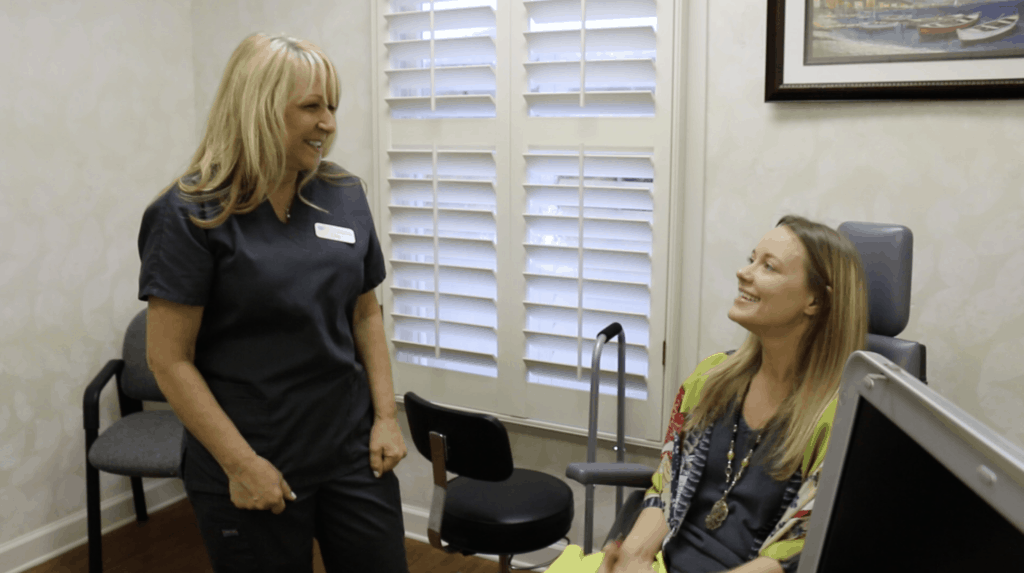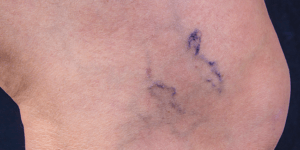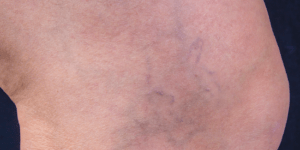The pain from varicose and spider veins forced Kelli to give up the things she most loved to do like dancing and going running with her dog. She often needed to rest in the middle of the day just to recover enough strength to get through the afternoon.
Kelli’s life changed when she came to the Vein Care Center of Amelia Island to receive sclerotherapy and phlebectomy treatment. “The biggest benefit of the treatments I received was I can now work out again,” says Kelli. “I can ride bikes, run, go hiking with my kids and do all this without being in pain or needing a nap by noon because my legs are on fire.”
What Are Varicose and Spider Veins?
Varicose veins affect roughly 23% of U.S. adults (about 30 million people) and are more common in women than men by a ratio of 60/40. Varicose veins are enlarged unsightly veins on the leg that are usually bluish and tend to bulge and twist up along the leg. They typically extend from the thigh down to the ankle, or any part of the leg. Spider veins are smaller more superficial veins that are bluish green in color and appear more on the surface of the skin.
If left untreated, varicose veins can lead to specific symptoms including:
- Heaviness in the legs
- Aches
- Pain
- Cramps
- Swelling
- At times restless leg syndrome
 “Dancing, running on a treadmill, running with my kids, anything that was heavy impact I couldn’t do before because my veins would swell and bulge so much,” says Kelli. “I had to wear compression stockings so that I could make it through the day.”
“Dancing, running on a treadmill, running with my kids, anything that was heavy impact I couldn’t do before because my veins would swell and bulge so much,” says Kelli. “I had to wear compression stockings so that I could make it through the day.”
Varicose veins can also generate discoloration of the skin, and in extreme cases, can lead to ulceration and breakdown of the skin. Varicose veins appear predominantly in the legs, but sometimes individuals can develop unsightly veins on the face that appear as tiny red lines and small veins. And some patients may develop bulging veins on their hands.
What Causes Varicose Veins?
Pregnancy can predispose women to varicose veins, but the leading causes are usually either genetic or occupational. People with parents or other close relatives who had varicose veins are more likely to get them, and individuals who spend a lot of time on their feet at work will be more at risk of developing unsightly veins as well.
Anatomical factors can also cause varicose veins. When a patient’s valves in the veins don’t close properly, it can create a backflow of blood moving in the wrong direction and increase the pressure in the veins of the leg. This can bring about varicose veins.
“Every time I would do something that was heavy impact, I could feel it the minute another vein would rupture,” says Kelli. “And I could feel it spreading up my leg, and it was always a concern, like, am I doing this too hard? Am I stepping too hard? Have I been on my feet too long today?”
How to Treat Varicose Veins?
 When no adverse symptoms are present, and if the presence of varicose veins does not bother a patient, medical intervention may not be necessary. Instead, a vascular surgeon may recommend specific lifestyle changes including:
When no adverse symptoms are present, and if the presence of varicose veins does not bother a patient, medical intervention may not be necessary. Instead, a vascular surgeon may recommend specific lifestyle changes including:
- Regular exercise
- Weight-loss plans
- Not wearing tight-fitting clothing or high heeled shoes
However, when pain, swelling or other problems persist, or a patient wishes to remove the varicose veins for cosmetic reasons, medical treatments may be recommended such as:
- Compression stockings – to prevent blood from pooling down in the legs
- Ablation therapy – injection, radiofrequency or laser treatment to close or remove the veins
- Sclerotherapy
What Is Sclerotherapy and How Is It Performed?
Sclerotherapy is a minimally invasive medical procedure used by vascular specialists to remove unwanted varicose and spider veins. The process involves injecting medicine, called sclerosing agents, into unhealthy veins. In addition to relieving discomfort, the injected chemicals cause the damaged veins to diminish and fade from view.
Using ultrasound, a tiny 30-gauge needle is woven through the vein, and a sclerosing solution injected into the pathway causing the vein to spasm, clot, and disappear. Treatments are typically done in the vascular surgeon’s office and are completed in about an hour.
“What made me decide to go ahead with the treatment was Lisa,” says Kelli. “She was extremely comforting, and she let me know that it wasn’t going to be painful and that they could address every issue that I needed.”
The supportive and caring attitude displayed by Dr. Kovacs and his staff put Kelli at ease, particularly after less than ideal experiences at other practices. “I saw multiple doctors all the way to Jacksonville, and I was completely scared of somebody cutting open my legs and removing any part of them,” says Kelli. “Dr. Kovacs was amazing. I never felt uncomfortable coming in, and they didn’t freak me out; they got the (sclerotherapy and phlebectomy) procedures done very fast so I could go home.”
“I didn’t feel it,” Kelli continues. “Sclerotherapy feels like pressure that’s it; there’s no pain involved. Afterward, the healing is great, and you just wear compression stockings. The worry was all in my head. It’s really not that bad.”
Results of Sclerotherapy
 Studies have proven the effectiveness of sclerotherapy in attaining a 60-80% success rate for eliminating varicose and spider veins. Less than one in ten patients have no improvement at all, and in that case, other chemical solutions can be employed.
Studies have proven the effectiveness of sclerotherapy in attaining a 60-80% success rate for eliminating varicose and spider veins. Less than one in ten patients have no improvement at all, and in that case, other chemical solutions can be employed.
Patients can return home immediately after the procedure and get back to their daily activities. However, patients should avoid strenuous exercise for at least two weeks after sclerotherapy.
“The staff here is amazing; they’re really kind,” says Kelli. “Dr. Kovacs is very precise. He addresses what the problem is and doesn’t throw a lot of big words in there that people aren’t going to understand. He let me know what needed to be done and he said that if I didn’t have the procedure, I would have a lot more anxiety dealing with a bigger issue later.”
Spider and varicose veins take time to dissolve. Patients may start seeing an immediate difference just three to four days after treatment but may not see the complete effects until a month or two after each sclerotherapy session.
After her successful varicose and spider vein treatments, Kelli is grateful to have recovered her quality of life and to be free from pain. “Before my treatment, it was challenging to spend fifteen minutes every day putting on compression stockings,” she says. “It is much nicer to be able to spend that time added up every day at a dance class, or running with my dog, or doing something that I couldn’t do before. I had a serious medical concern, and I thought I was going to end up with a clot or another bulging vein. I don’t have to worry about that anymore. I can do anything I want. I have freedom.”
